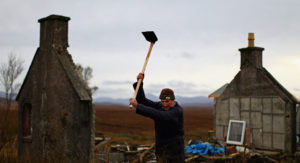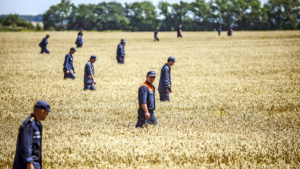Among the rural professions, we hedgelayers get an easier time of it than most. Not in a physical sense, of course. Laying hedges is skilled hard graft. By the end of the season, which runs from the first day of September to the last of this, my forearms look like Popeye’s if he’d been in a knife fight. The muscles of my upper body are asymmetrical: my right shoulder and bicep bulge like those of a middleweight boxer, from wielding billhook and lump hammer; my left side is weedier, although, like the rest of me, it is scratched like a school chapel pew. Yet, while I may receive a physical mauling each day, I am largely unwounded by the rural culture wars.
Overwhelmingly these brickbats are reserved for my agricultural colleagues; and no one lobs a brick at a yokel harder than George Monbiot, the archbishop of farmer-bashing. He reserves his most ardent damnations for livestock farmers, claiming for instance that “sheep farming in the UK has caused more ecological destruction than the entire built environment”. That being said, he is quite prepared to be a generalist in his hyperbole, intoning in his elitist tome Regenesis that, “farming is the number one threat to the planet”.
The hedge, too, is a blackthorn stick with which the anti-agri brigade beat our farmers. Every autumn, Twitter is flooded with photos of hedgerows that have been subjected to a hard cut by man and machine. Hashtags such as #Hedgewrecks are de rigueur; worse still, there is poetry. The fact that a farmer will face hefty fines, and lose subsidies, if he permits hedgerows to encroach a public right of way is ignored in the rush to make a self-righteous whinge.
This farmer-hate is curious. We all eat their produce. True, farmers aren’t altruistic angels: it is a career choice like any other. But the environmentalists, journalists and clicktivists who attack them completely misunderstand how the beloved landscapes of the English countryside are actually shaped. It is the actions of farmers, over many millennia, that are overwhelmingly responsible for, albeit inadvertently, creating much of the most familiar features. And there is no better evidence of this than the English hedgerow.
I’d like to think we hedgers are looked upon kindly because of the ancient beauty and intricacy of our craft. But perhaps it was hedgelaying’s appearance on Clarkson’s Farm that gave us a popularity boost. On reflection, however, I think England is so fond of us not for our actual work, but our workplace: the hedgerow itself. It is a bucolic archetype of English arcadia. Where woods are otherworldly and forests haunting, the hedgerow is homely: a place of blackberry picking and yellowhammers singing.
But there would be no hedges without farmers. As early as 2500BC, proto-farmers were planting lines of thorny shrub species such as blackthorn, and then managing them by cutting and laying, all in order to create a semi-permanent livestock barrier. Then, as now, the hedge was in no way natural. Left to its own devices, a hedge will, after 30 years or so, morph into a straggly line of whippy trees, becoming a significantly poorer habitat than in its original man-made form. Today, the hedgerow is celebrated for the ecological role it plays, providing habitats for a huge range of wild animals: birds, mammals, and invertebrates. But they are not themselves wild. And the management interventions required to maintain these habitats are all entirely born of farming. It was mere happenstance that the hedge, man-managed to be sufficiently thick to retain a bullock or prevent a lamb from making a bid for freedom, also ideally suited the nesting linnet, bullfinch or whitethroat.
Hedges are functional, first and foremost. They have, therefore, been a permanently fluctuating feature of our rural landscape, reflecting the vagaries of the economy, population growth, and perpetual innovation in farming practice. The hedgerow expands when agriculture is flourishing; after the passing of the Enclosure Act in 1773, thousands of miles of new hedge were planted. However, come any agricultural downturn, such as the one that followed the defeat of Napoleon, our hedges dwindle, left to become gappy ruins. Many were grubbed out after the Second World War — though this was not agrarian devilment but the diktat of the Attlee government’s Ministry of Food, desperate to eke maximum production from farmland to feed a hungry post-war nation.
At the moment, our hedgerows are emerging from one of their cyclical periods of decline. A mapping project at the start of the year revealed that there are currently 390,000 km of English farmland hedges — enough to “wrap 10 times around the earth”. Yet the scientists involved were at pains to claim this huge figure is insufficient, saying that we have “lost approximately half of our hedgerows since the Forties”. Obviously, that statement is a guess, since we haven’t measured our hedges until now. But Hedgelink, the Tree Council and the National Farmers’ Union are all in agreement that we need more to improve biodiversity.
The Government is on board: last year it announced that farmers must plant 45,000 miles of new hedgerows by 2050. But it is vital that existing hedgerows are well managed. Defra’s support for this is one of the few bits of the post-Brexit “Environmental Land Management” policy generally deemed fit for purpose. The grants available for laying, coppicing, gapping up or planting new hedges are sufficiently generous and accessible — in fact, 90% of my work is funded by them. So there are few excuses for landowners not to better manage their hedgerows or add more.
The trouble is, there are not enough people to do the job. While there is a glut of ecologists happy to charge farmers for advice on their hedgerows — the same cannot be said for those who actually do the hard graft. Just as the NFU believes there is a need for 49% more agricultural workers, the Chartered Institute of Foresters estimates a 70% shortfall in the arboricultural workforce. While ecology graduates struggle to find jobs — complaining that supply outweighs demand — not enough people want to get their hands dirty. I understand why young people might shun farming: you’ll only get slagged off by Team Monbiot. Yet the same cannot be said for a life spent in the hedgerows and coppice woods. The public loves us. And surely life as a hedger is the perfect alternative for those keen ecologists waiting forlornly for a role that never materialises?
If we are ever to maintain, let alone expand, our hedgerows, we need to invest in the practice, not just the theory. Universities clearly would never condescend to teach anything other than concept, and specialist land-based colleges have declined by 80% in the past four decades. Those still running offer little more than a few days’ practical instruction in hedgerow management. I wonder: is this because modern society, which claims to care so passionately for the environment, has become too urbane, or urban, for young people to contemplate a career spent working on the land?
If so, this is a pity. A hedgelayer today is no mere billhook-wielding rustic. Our modern role requires brains as well as experience: it is a question of highly skilled brawn. The fact that few seem interested in rising to the challenge is an existential threat to the craft of hedgelaying. But this concern pales into insignificance compared to the threat to the hedge itself — and the myriad wildlife that calls them home. Like the blackberry bushes and the yellowhammers, these arteries of the land need guardians.
Disclaimer
Some of the posts we share are controversial and we do not necessarily agree with them in the whole extend. Sometimes we agree with the content or part of it but we do not agree with the narration or language. Nevertheless we find them somehow interesting, valuable and/or informative or we share them, because we strongly believe in freedom of speech, free press and journalism. We strongly encourage you to have a critical approach to all the content, do your own research and analysis to build your own opinion.
We would be glad to have your feedback.
Source: UnHerd Read the original article here: https://unherd.com/




